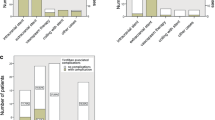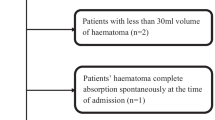Abstract
Stent-assisted coiling (SAC) of acutely ruptured aneurysms with antiplatelet therapy has been controversial. Tirofiban has been used for the treatment of thromboembolism of ruptured aneurysms with a stent. However, there are few comparative studies of a reasonable dosage for the prophylactic use of tirofiban. This study evaluated the safety and efficacy of reducing the dosage of tirofiban for the ruptured aneurysms with SAC. Patients with ruptured intracranial aneurysms in our institution from January 2014 to June 2018 were retrospectively reviewed. Three hundred and nine patients were treated using SAC within 72 h of onset. Patients were divided into either a standard group (211 patients, 10 μg/kg intravenous bolus within 3 min, maintained with 0.15 μg/kg/min) or a half-dose group (98 patients, 5 μg/kg intravenous bolus within 3 min, maintained with 0.075 μg/kg/min) according to the dose of tirofiban received intraoperatively. Medical records including clinical and radiological details were reviewed. No significant differences in demographic information or aneurysm characteristics existed between the two groups. Thromboembolic complications were found in 15 patients (4.9%), including 11 patients (5.2%) in the standard group and four patients (4.1%) in the half-dose group, without significant difference (P = 0.782). Intracranial hemorrhage was found in 13 patients (4.2%), and all occurred in the standard group, which was significantly different (6.2% vs 0%, P = 0.011). Of these 13 patients, four were left disabled and five died. Except for three patients who had intraoperative aneurysm rupture, the incidence of postoperative early rebleeding (10 patients) was significantly different between the two groups (4.7% vs 0%, P = 0.034). The rate of initial complete occlusion in the half-dose group was significantly higher than that in the standard group (55.1% vs 39.8%). The rate of a good outcome (modified Rankin Scale 0–2) was not significantly different between the standard group and half-dose group (78.7% vs 87.8%, P > 0.05). Intravenous tirofiban for SAC of acutely ruptured intracranial aneurysms is feasible and safe. The half-dose tirofiban treatment was associated with a decrease in the prevalence of intracranial hemorrhage but no increase in thromboembolic events compared with those in standard-dose tirofiban treatment.

Similar content being viewed by others
References
Molyneux AJ, Kerr RS, Yu LM, Clarke M, Sneade M, Yarnold JA et al (2005) International subarachnoid aneurysm trial (ISAT) of neurosurgical clipping versus endovascular coiling in 2143 patients with ruptured intracranial aneurysms: a randomised comparison of effects on survival, dependency, seizures, rebleeding, subgroups, and aneurysm occlusion. Lancet 366:809–817
(1997) Effects of platelet glycoprotein iib/iiia blockade with tirofiban on adverse cardiac events in patients with unstable angina or acute myocardial infarction undergoing coronary angioplasty. The restore investigators. Randomized efficacy study of tirofiban for outcomes and restenosis. Circulation 96:1445–1453
Liu Y, Su Q, Li L (2014) Safety and efficacy of early administration of tirofiban in patients with acute st-segment elevation myocardial infarction undergoing primary percutaneous coronary intervention: a meta-analysis. Chin Med J 127:1126–1132
Kang HS, Kwon BJ, Roh HG, Yoon SW, Chang HW, Kim JE, Han MH (2008) Intra-arterial tirofiban infusion for thromboembolism during endovascular treatment of intracranial aneurysms. Neurosurgery. 63:230–237 discussion 237-238
Bruening R, Mueller-Schunk S, Morhard D, Seelos KC, Brueckmann H, Schmid-Elsaesser R, Straube A, Mayer TE (2006) Intraprocedural thrombus formation during coil placement in ruptured intracranial aneurysms: treatment with systemic application of the glycoprotein iib/iiia antagonist tirofiban. AJNR Am J Neuroradiol 27:1326–1331
Hong B, Patel NV, Gounis MJ, DeLeo MJ, Linfante I, Wojak JC et al (2009) Semi-jailing technique for coil embolization of complex, wide-necked intracranial aneurysms. Neurosurgery. 65:1131–1138 discussion 1138-1139
Connolly ES Jr, Rabinstein AA, Carhuapoma JR, Derdeyn CP, Dion J, Higashida RT, Hoh BL, Kirkness CJ, Naidech AM, Ogilvy CS, Patel AB, Thompson BG, Vespa P (2012) Guidelines for the management of aneurysmal subarachnoid hemorrhage: a guideline for healthcare professionals from the american heart association/american stroke association. Stroke. 43:1711–1737
Liang XD, Wang ZL, Li TX, He YK, Bai WX, Wang YY, Zhou GY (2016) Safety and efficacy of a new prophylactic tirofiban protocol without oral intraoperative antiplatelet therapy for endovascular treatment of ruptured intracranial aneurysms. J Neurointerv Surg. 8:1148–1153
Raymond J, Guilbert F, Weill A, Georganos SA, Juravsky L, Lambert A et al (2003) Long-term angiographic recurrences after selective endovascular treatment of aneurysms with detachable coils. Stroke. 34:1398–1403
Rordorf G, Bellon RJ, Budzik RE Jr, Farkas J, Reinking GF, Pergolizzi RS et al (2001) Silent thromboembolic events associated with the treatment of unruptured cerebral aneurysms by use of guglielmi detachable coils: prospective study applying diffusion-weighted imaging. AJNR Am J Neuroradiol 22:5–10
Yang P, Zhao K, Zhou Y, Zhao R, Zhang L, Zhao W, Hong B, Xu Y, Huang Q, Krings T, Liu J (2015) Stent-assisted coil placement for the treatment of 211 acutely ruptured wide-necked intracranial aneurysms: a single-center 11-year experience. Radiology. 276:545–552
Bodily KD, Cloft HJ, Lanzino G, Fiorella DJ, White PM, Kallmes DF (2011) Stent-assisted coiling in acutely ruptured intracranial aneurysms: a qualitative, systematic review of the literature. AJNR Am J Neuroradiol 32:1232–1236
Vilahur G, Choi BG, Zafar MU, Viles-Gonzalez JF, Vorchheimer DA, Fuster V et al (2007) Normalization of platelet reactivity in clopidogrel-treated subjects. J Thromb Haemost 5:82–90
Lee DH, Arat A, Morsi H, Shaltoni H, Harris JR, Mawad ME (2008) Dual antiplatelet therapy monitoring for neurointerventional procedures using a point-of-care platelet function test: a single-center experience. AJNR Am J Neuroradiol 29:1389–1394
Zi-Liang W, Xiao-Dong L, Tian-Xiao L, Liang-Fu Z, Jiang-Yu X, Wei-Xing B, Ying-Kun H, Gang-Qin X, Qiu-Ji S, Li L, Guang F, Zhao-Shuo L (2017) Intravenous administration of tirofiban versus loading dose of oral clopidogrel for preventing thromboembolism in stent-assisted coiling of intracranial aneurysms. Int J Stroke 12:553–559
Harder S, Klinkhardt U, Alvarez JM (2004) Avoidance of bleeding during surgery in patients receiving anticoagulant and/or antiplatelet therapy: pharmacokinetic and pharmacodynamic considerations. Clin Pharmacokinet 43:963–981
Ryu CW, Park S, Shin HS, Koh JS (2015) Complications in stent-assisted endovascular therapy of ruptured intracranial aneurysms and relevance to antiplatelet administration: a systematic review. AJNR Am J Neuroradiol 36:1682–1688
Chalouhi N, Atallah E, Jabbour P, Patel PD, Starke RM, Hasan D (2017) Aspirin for the prevention of intracranial aneurysm rupture. Neurosurgery. 64:114–118
Can A, Rudy RF, Castro VM, Yu S, Dligach D, Finan S, Gainer V, Shadick NA, Savova G, Murphy S, Cai T, Weiss ST, du R (2018) Association between aspirin dose and subarachnoid hemorrhage from saccular aneurysms: a case-control study. Neurology. 91:e1175–e1181
Kim S, Choi JH, Kang M, Cha JK, Huh JT (2016) Safety and efficacy of intravenous tirofiban as antiplatelet premedication for stent-assisted coiling in acutely ruptured intracranial aneurysms. AJNR Am J Neuroradiol 37:508–514
Chalouhi N, Jabbour P, Kung D, Hasan D (2012) Safety and efficacy of tirofiban in stent-assisted coil embolization of intracranial aneurysms. Neurosurgery. 71:710–714 discussion 714
Chalouhi N, Jabbour P, Daou B, Starke RM, Shields B, Hasan DM (2016) A new protocol for anticoagulation with tirofiban during flow diversion. Neurosurgery. 78:670–674
Egashira Y, Yoshimura S, Enomoto Y, Ishiguro M, Asano T, Iwama T (2013) Ultra-early endovascular embolization of ruptured cerebral aneurysm and the increased risk of hematoma growth unrelated to aneurysmal rebleeding. J Neurosurg 118:1003–1008
Sluzewski M, van Rooij WJ (2005) Early rebleeding after coiling of ruptured cerebral aneurysms: incidence, morbidity, and risk factors. AJNR Am J Neuroradiol 26:1739–1743
Cho YD, Lee JY, Seo JH, Kang HS, Kim JE, Kwon OK, Chung YS, Han MH (2012) Early recurrent hemorrhage after coil embolization in ruptured intracranial aneurysms. Neuroradiology. 54:719–726
Youssef PP, Dornbos Iii D, Peterson J, Sweid A, Zakeri A, Nimjee SM et al (2020) Woven endobridge (web) device in the treatment of ruptured aneurysms. J Neurointerv Surg 0:1–5
Funding
The study was supported by National Key R&D Program of China (2016YFC1300700) and Natural Science Foundation of China (No. 81771264).
Author information
Authors and Affiliations
Corresponding authors
Ethics declarations
Conflict of interest
The authors declare that they have no conflict of interest.
Ethical approval
All procedures performed in the studies involving human participants were in accordance with the ethical standards of the institutional research committee and with the 1964 Helsinki Declaration and its later amendments or comparable ethical standards.
Informed consent
Informed consent was obtained from all individual participants included in the study.
Additional information
Publisher’s note
Springer Nature remains neutral with regard to jurisdictional claims in published maps and institutional affiliations.
Rights and permissions
About this article
Cite this article
Yan, Y., He, X., Fang, Y. et al. The safety and efficacy of low-dosage tirofiban for stent-assisted coiling of ruptured intracranial aneurysms. Neurosurg Rev 44, 2211–2218 (2021). https://doi.org/10.1007/s10143-020-01398-w
Received:
Revised:
Accepted:
Published:
Issue Date:
DOI: https://doi.org/10.1007/s10143-020-01398-w




